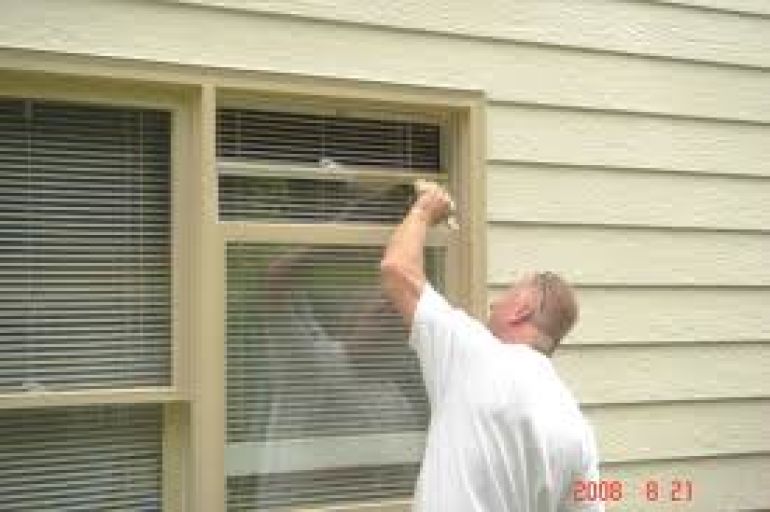My home painting story
I have a 3 bedroom weatherboard home that was built in the 50's. Since it was built, there've clearly been a collection of different people with different tastes not only living in the house at separate times, but also people who couldn't seem to compromise and meet in the middle - leading to pink flowery wallpaper in one room and dark purple paint in another. Murderously bad taste!

After a few other renovations (new instant hot water service to reduce the energy consumption of the electric hot water tank, changing some powerpoint locations and adding new ones, installing some new windows to replace the exceptionally thin ones that don't keep heat out or warmth in) I was ready to start with the fun stuff. I've always loved painting walls but a whole house was a bit of a challenge especially with the amount of work to be done before I could start painting...
Before I could even THINK about painting I needed to do some preparation work.
Step 1: Removing wallpaper off some walls.
Removing wallpaper can be easy, or it can be difficult. For me, it was mostly difficult. In some parts, there was more than one layer of wallpaper, and also the plasterboard underneath the wallpaper wasn't all smooth so the wallpaper seemed to stick SO much better. I rented a wallpaper steam remover which was the only reason why it was even possible to remove the wallpaper. I tried a few other ways to remove wallpaper before renting one (using a sponge to wet the paper, dry peeling, scraping like mad) but they were all far too difficult and time consuming. The wallpaper remover sprays the wallpaper with steam and melts the glue which makes it easier to scrape the paper off in big, gross clumps of mess. Don't imagine that this kind of DIY is the kind where you can look anything but disgusting the whole time you're doing it either - it's exceptionally unglamorous.
Tip: When removing wallpaper with a steamer, don't use paper to cover the floors - use plastic or material. Paper gets wet and just melts into the carpet and makes FAR more mess.
How long does it take to remove wallpaper? It depends on the job. This one was more difficult than most, so it took about 7 hours to do one largish room, and 3 hours to do the kitchen (which was partially tiled as well).
Tip: Remember, you're filling a room with steam (if you're working fast with the steamer on constantly) so the steam won't all condense on the wall. You'll find that the ceiling get's a lot of moisture on it which means that light fixtures could be exposed to water. A wet ceiling is also a good opportunity to clean the ceiling with a mop or cloth.
In hindsight, removing the wallpaper was a waste of time. The plasterboard underneath was so old, cracked and patchy with many different levels of paint underneath - clearly the reason why someone chose to wallpaper!
Step 2: Cleaning, sanding, and re-cleaning the walls
Once the wallpaper was removed, the disgusting walls underneath were exposed. Some glue remained so I needed to wash the walls with sugar soap first, but then would also have to patch and sand the walls back for a smooth surface. This was a massive pain and using a manual sander was a big mistake. Not only was it a lot of effort but also my efforts weren't rewarded with a smooth, paintable surface. At the end of the day, the walls were still not good enough to paint over - which I proved by buying some cheap quite paint and giving a section three coats before establishing that even all that preparation and three coats of paint wasn't going to give me the smooth walls I wanted.
Tip: Floor mops are also good for walls (the spongey type).
Tip: Sugar soap is absolutely the best, don't bother with anything else.
Tip: Bribe friends to help with the sanding. Or, you could get an electric sander but you'd need to be careful not to overdo it on the plaster and choose finer paper.
Step 3: Choosing paint
So although I didn't have a good painting surface I decided to contemplate that problem at length and get onto the fun stuff. Choosing paint colours and types. I read these articles which were VERY helpful in making my paint choice.
- Paint colours that make the room look bigger
- Painting - Selecting Paint: Acrylic or Oil, Cheap or Expensive?
- Buying the right paint
I got a few colour options in tester pots (surprisingly expensive for these little pot things) but it was worth it as I soon realised that my choices were pretty but way too dark for the rooms. Also, I never knew anything about environmentally friendly paint but I did my research and chose a variety with low VOC's.
Step 4: Preparing the walls take 2!
It seemed like I was at an impasse. I couldn't get the surface smooth by filling and sanding. Then I found this great article about two other options and it seemed that my decision was simple. I was going to have to get a professional to reskim the plaster and then do the painting myself afterwards. MUCH irritation at the expense and effort of removing the wallpaper when I probably didn't need to but apparently I would have had to do that anyway (unlike with replacing the plasterboard where it would have been a complete waste!).
Thought about doing the plastering myself but decided I didn't have the skill and wanted the job done well so posted a job on Service Central and got three great companies to quote. They all came in at around the same price (it seems it's quite competitive) and so I chose based on the fact that one of the guys had a higher feedback rating than the other two companies. Booked him in, and the whole process from posting my job to having it done was a total of 4 days. Wow. I was super keen to start painting so I popped the humidifier on in the newly re-skimmed bedroom as per this advice and headed to the other rooms.
The other rooms were far less complicated. A few cracks to patch, a few holes to fill but no layers of paint or wallpaper. The dark purple one would need a brilliant white undercoat to lift the colour, and the other walls just needed a clean after doing the patching and then I'd be ready to paint. Decided to leave the kitchen completely as there's a long term renovation plan and nothing I do in the short term is going to make it better…
Step 5: Ready to paint
So, after a few days I had a whole house (except the kitchen) that was ready for painting. I'd chosen my paint, bought my drop cloths, painters tape, brushes, rollers, etc. I started with a small room and it took me 4 hours in total to paint (with breaks in between for drying) - but it was a super small room and I only needed two coats. I forgot that I'd have to either tape up light fittings or loosen them and that was a bit fiddly and took a while. I calculated that it was going to take me at least 5 days painting to do most of it, after the 4 days I've spent preparing the walls and 1 day it took to reskim the one room. So much for being a quick and easy project!
I got to it. By the time I'd finished the second smallest room my arms and shoulders were stiff from being in the same position the whole time, my feet were sore from standing on the ladder and I'd realised I was doing a pretty poor job - this article confirmed it for me. I would have persevered because I was getting better at it by being more careful but after the whole ordeal I was sick of having drop cloths everywhere and paint fumes and paint stacked up in every corner of my house… So I gave in and hired a professional. Because I'd done all the preparation work AND bought the paint it was cheap cheap - the company I chose was in and out in one day and did a far better job than I. They even fixed up a bit of my mess in the first two rooms for free.


